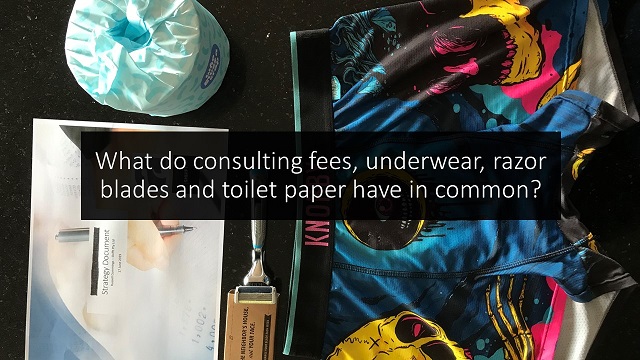What do consulting fees, underwear, razor blades and toilet paper have in common?
OK, so what do consulting fees, underwear, razor blades and toilet paper all have in common?
The real connection is that they all have a similar mechanism for charging for their services or products. They are all part of a subscription model.
Pricing your products and services is a highly strategic activity that is core to your Marketing Strategy and is often overlooked by business owners. Too many people take the easy way out and do exactly what the competition is doing. They charge a similar amount and do this in a the same way as the others.
What we are failing to grasp is that pricing is a key Positioning Strategy for your business and by copying the competition we are losing any competitive advantage that we may potentially gain. You can gain this advantage in many ways but 2 key areas are:
1. Your Price Level – what does your product (or service) cost relative to the competition?
2. Pricing Mechanism – How do you charge for your services/product? fixed fee, RRP, subscription, hourly rate, commission, etc.
Setting your Prices
There are 5 common tools for setting prices:
- Cost Plus
- RRP
- Competitor Pricing
- Market Will Bear
- Target Pricing
Cost Plus – as the name suggests is a very common way to price based on your costs. Simply add up your costs to deliver and add a margin for profit and voila you have your price.
RRP – This is where your supplier sets the pricing via a “Recommended Retail Price” Model. You will usually have purchased the product at a wholesale level with an in-built margin to get to RRP. You may also be restricted by Government Policy in some areas like: healthcare.
Competitor Pricing – This is where you base your pricing on the competition and it can be a dangerous strategy as its easy to price to low. Some of your competitors will have poor business skills and will no understand how to price to make a profit.
Market Will Bear – this is where you test your pricing in the market and keep work out where will give you the best return in terms of volume and price. This takes some effort but is often the better strategy for your business.
Target Pricing – This is a different technique that involves determining the price that will generate the most sales for your business. You then deduct your profit to determine a target cost for your product or service. Using this information you can then decide what to features, benefits, packaging, distribution options to include in order to meet your cost target. Its a powerful pricing tool that is rarely used but I suggest that you give it a run.
In reality, we should use a variety of pricing tools to help set our price unless RRP is your only option. My experience is that Cost Plus should set the minimum price. Competitor Pricing should allow us to explore the range (use the phone (mystery shopper calls) and/or internet to do a quick scan of competitor pricing. Typically, if your products are of similar quality them set your price below that market leaders and above the average and use “Market Will Bear” and/or “Target Pricing” to explore some pricing options and lift your prices above the competition.
Establishing a Pricing Mechanism
The second element to consider is your pricing mechanism. Again, don’t be lazy and accept what the competition is doing.
20 odd years ago, when I went out on my own as a Business Consultant everyone charged by a the hour or day for their services. When I asked my clients what they disliked about the “Professionals” that they worked with the overwhelming response was high hourly rates and a “surprise” in the mail (the bill). I explored a range of options with my clients and settled on an agreed fee broken down into monthly installments like a “subscription”. That pricing mechanism has the been the basis for my successful coaching services for the last 20 years. Check out my website to see how the coaching programs play out – https://www.shifft.com.au/programs/
Now I have a range of innovative suppliers including software (SAAS – “Software as a Service” aka a Subscription) and the products i mentioned above, that are all using a subscription model to differentiate their business:
Underwear – Australian Company “Knobby” (https://knobbyunderwear.com.au/) delivers me a quality pair of jocks every month. Each month has a unique design and they are the most comfortable “jocks” I’ve worn for years. Who would have thought there was a market to buy underwear by subscription?
Razor Blades – Fed up with paying extortionate prices for razor blades from the majors, I went looking for options to provide me with a quality product for less. I soon found Dollar Shave Club (https://au.dollarshaveclub.com/home) who deliver me high quality razor blades and shaving products on subscription basis.
Toilet Paper – We have been buying out TP on subscription for a couple of years from social Who Gives a Crap (https://au.whogivesacrap.org/) a socially driven business that donates 50% of profits to build toilets in the developing world. The product quality is excellent and it arrives on a regular schedule.
These are just a few examples of the types of products and services that you can access via a different pricing model – in this case: subscription. For each pricing model there will be pros and cons but unless we explore some alternatives and look beyond copying what everyone else is doing then we will fail to differentiate our business in the marketplace.
How could you build a subscription model into your product or service offer?
I’d also be interested in your experiences with trying different pricing models for your business and/or businesses that you use. Comment below.

